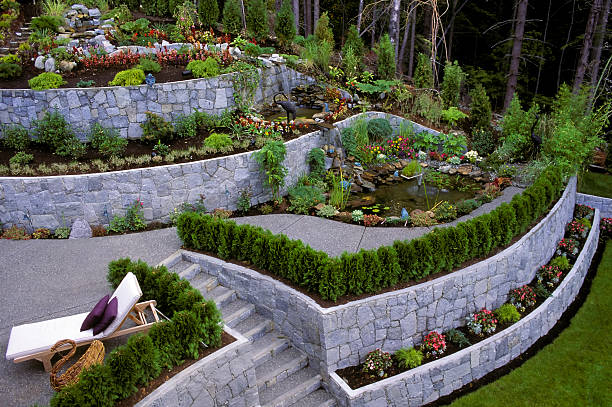Retaining walls are a remarkable fusion of art and engineering, playing a crucial role in both functional landscaping and aesthetic enhancement. These structures, designed to hold back soil and create level areas, are not only essential for managing terrain but also offer unique opportunities to add beauty and character to outdoor spaces.
Engineering Principles of Retaining Walls
At the core of retaining walls lies robust engineering, ensuring stability and longevity. The primary purpose of a retaining wall is to counteract the natural tendency of soil to move due to gravity, which can cause erosion or landslides on sloped terrains.
Materials and Design Considerations
The choice of materials is vital in the construction of retaining walls. Common materials include stone, concrete, wood, and brick, each offering distinct structural and aesthetic benefits. The selection depends on factors such as the height of the wall, the soil type, and environmental conditions.
Design considerations also include drainage solutions, as water buildup behind the wall can lead to failure. Proper drainage systems, like gravel backfills or weep holes, are integrated into the design to prevent water pressure from compromising the wall’s integrity.
Construction Techniques
Construction techniques vary depending on the materials used. For instance, stone retaining walls often utilize dry-stacking methods, where stones are carefully placed without mortar, relying on gravity and friction. Concrete walls may involve poured or precast methods, providing strength and durability. Each technique requires careful planning and execution, especially during excavation, like those available in West Valley City, to ensure the wall can withstand the stresses of the retained soil.
Artistic Potential of Retaining Walls
Retaining walls are not just functional structures; they also provide an opportunity to enhance the aesthetic quality of a landscape. By incorporating various design elements, such as curves, textures, and plantings, these walls can become focal points in gardens and outdoor spaces. Landscape architects often leverage retaining walls to create tiered garden beds, allowing for an impressive display of flowers, shrubs, and other plant life.
Additionally, integrating lighting features into retaining wall designs can illuminate pathways and create a welcoming atmosphere during the evening, further enhancing the overall appeal of the outdoor environment.
Enhancing Garden and Landscape Designs
Retaining walls can define spaces within a garden, creating terraces for planting or establishing distinct zones for different activities. They can be built to complement the natural contours of the land, preserving the organic flow of the landscape while adding structure.
Examples of Styles and Materials
The aesthetic appeal of retaining walls can be tailored to suit diverse design preferences.
- Stone Walls: These offer a rustic, timeless look and blend seamlessly with natural surroundings. Varieties like stacked fieldstone or cut stone provide texture and warmth, enhancing the organic feel of a garden.
- Wood Walls: Using timber gives a more natural, warm appearance, ideal for informal garden settings. Wood can be stained or left to weather naturally, adding an evolving element to the landscape.
- Concrete Walls: Known for their versatility, concrete walls can be molded into sleek, modern designs or textured to mimic natural stone. They offer a clean, contemporary look that pairs well with minimalist landscaping styles.
Creative Applications
Retaining walls can do more than just hold back soil. They can incorporate seating areas, serve as backdrop walls for water features, or support vertical gardens. Lighting elements can be integrated to highlight textures and create ambiance at night, transforming the wall into a focal point of the landscape.
Conclusion
Retaining walls blend art and engineering, balancing functionality with aesthetic appeal. By understanding engineering principles and exploring artistic options, homeowners and designers can create walls that not only serve essential purposes but also enhance outdoor beauty.

